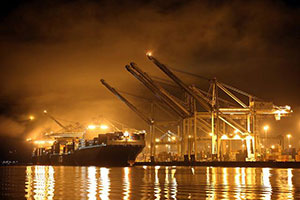Oakland Port Slashes Dirty Diesel Pollution in Long Campaign

Margaret Gordon used to clean the windows and blinds of her West Oakland, California, home once a week a decade ago to remove the black, gritty soot from diesel air pollution that drifted in from trucks and ships at the nearby Port of Oakland.
Now she cleans them less often after government and business invested well in excess of $100 million in ships, trucks and trains to cut port diesel particle emissions by 75% since 2015 — a striking reversal of fortune for the West Oakland environment.
Diesel truck soot dropped a whopping 98% and ship soot by 76%, the port announced in a report Oct. 28.
“Now I don’t have to clean my blinds every week,” Gordon, an environmental activist, said Oct. 28 after listening to a port news conference about the clean-air progress. “Now I can get along with cleaning every two weeks or so. That is my test. Also, I don’t have asthma flare-up as much as I used to.”
She called the changes “good progress,” adding that “there is more work to do.”
Port managers and clean-air regulators agreed with her Oct. 28 as they announced the results of their multifaceted campaign to reduce diesel soot, a toxic air contaminant linked to higher asthma rates in West Oakland.
All told, diesel emissions from all port sources — including harbor craft and loading equipment — declined 75% from 261 tons in 2005 to 62.3 tons in 2015, according to the port, the fifth-busiest container port in America.
The biggest clean-air strides came from ocean-going ships, which slashed their diesel particulate emissions from 208.5 tons during 2005 to 51.8 tons in 2015.
Diesel truck emissions plunged from 15.9 tons of diesel particulates in 2005 to 0.4 tons during 2015, port environmental managers reported.
“We are moving in the right direction,” Chris Lytle, the port executive director, said at the new conference where he was flanked by shipping and trucking company executives and environmental regulators. “This should have a benefit in cleaner air for West Oakland and reduce cases of asthma.”
A decade ago, environmental groups, community leaders and the region’s air-quality agency sharply criticized the port for not doing more sooner to cut emissions in West Oakland, one of the Bay Area’s toxic hot spots for air pollution.
Since then, however, the port, the state and other government agencies have invested some $100 million for cleaner trucks, ships, trains, tugs and power systems. Also, private truckers and shippers have invested many millions more toward cleaner vehicles.
Some $38 million was given out in grants to truck owners to buy new diesel trucks or install diesel filters on existing ones. Dirty trucks were banned from visiting the port.
The port spent $60 million on a dockside electric power system allowing visiting ships to plug into electricity to operate their ships in port instead of having to run their diesel engines. Ships that visit California ports also have been required by the state to burn lower-sulfur fuel while on or near the state’s coastline.
“The port stepped up,” said Jack Broadbent, chief executive officer of the Bay Area Air Quality Management District, an agency the pressed the port for changes. “This is a success story we should be proud of, but there is more work to be done.”
Broadbent and port officials said more pollution cuts can be made by getting a higher percentage of visiting ships to install the on-board equipment so they can run on electricity while in port.
Broadbent also said he is hopeful that electric trucks can be developed with enough power to supplant diesel as the work horses for carrying freight to and from ports.
Lynette Gibson-McElhany, the Oakland City Council president, said the air quality improvements will reduce high asthma rates for West Oakland children.
“At the end of the day, we are talking about people’s lives,” said Gibson-McElhany, who has a son and other relatives with asthma. “People with asthma will have a little less to worry about, and the air will be a little easier to breathe.”




